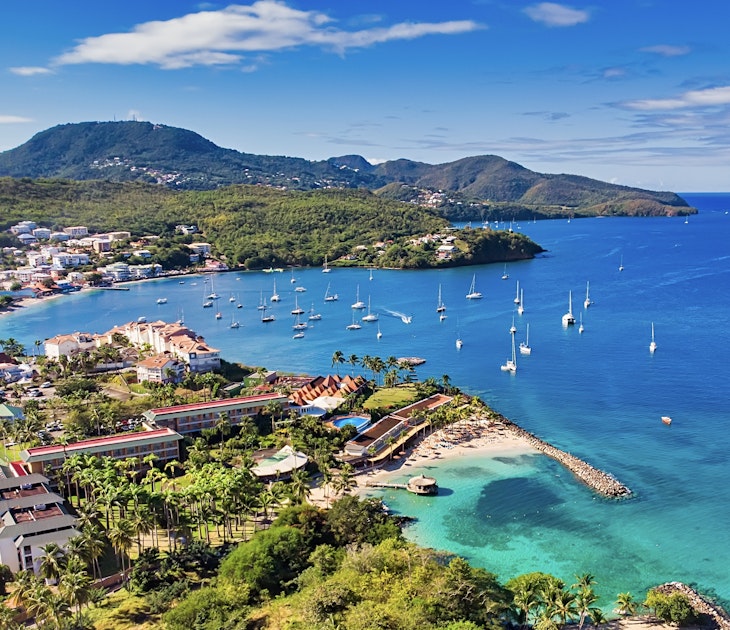

A reveller of the Sao Clemente performs on the first night of Rio's Carnival at the Sambadrome in Rio de Janeiro, Brazil, on February 11, 2018. © MAURO PIMENTEL/AFP/Getty Images
Brazilians know how to throw a party on a mammoth scale and make other festivals look like trainspotting conventions. So charge your caipirinhas, don your most sequined outfit and samba your way through the hottest carnivals in Brazil.

Rio de Janeiro
One of the world's largest parties, Carnaval – in all its colorful, hedonistic bacchanalia – is virtually synonymous with Rio. Held over five days of revelry 40 days before Easter, from Saturday to Ash Wednesday, residents of Rio begin the partying months in advance. Parades featuring elaborate floats flanked by thousands of pounding drummers and twirling dancers, is the culmination of the festivities – though the real action, Cariocas profess, is at the wild street parties held all over town.

Visitors are welcome to join the mayhem. There are free live concerts happening all over the city, while those seeking a bit of decadence can head to the various balls about town. Whatever you do, prepare yourself for sleepless nights, plenty of caipirinhas (Brazil’s national cocktail: cachaça with crushed lime, sugar and ice), samba and joyful crowds.

Copacabana beach, Rio de Janeiro
The best way to see in the New Year is to join the Reveillon party on Rio's mighty Copacabana beach, where the spiritual and the secular come together for one amazing night. Two million people pack the sands to welcome in the New Year. From about 8pm, top bands perform on stages strung out along the 4km-long beach, pumping out a variety of Brazilian and international music. At midnight, a spectacular fireworks display lights up the night sky while the hardiest of revelers keep things going until sunrise.

Salvador
Carnival in Salvador happens on the streets in late February to early March, where music and spontaneity rule and trios elétricos (electrically amplified bands playing atop speaker-laden trucks) work two million revelers into a frenzy. For an entire week they dance, drink and kiss until they drop, get up the next day and start again. Each year the city designates a theme for Carnaval, and decorates the city accordingly.

Belém
The largest festival on the River Amazon, Círio de Nazaré revolves around a small statue of Nossa Senhora de Nazaré (Our Lady of Nazareth) which is believed to have performed miracles. Since 1793, Brazilians have come to honor the Virgin and carry the statue from Belem to Icoaraci and back in a river procession of hundreds of boats. Millions of people fill the streets during the second week of October, along with the sounds of hymns, bells and fireworks, to accompany the image from Catedral da Sé to the basilica.

São Luís, Maranhão
Bumba Meu Boi is a wild, folkloric festival is derived from African, indigenous and Portuguese influences that mingled in colonial times. The event, held from late July until mid-August, revolves around the story of the ox's death and resurrection. Accompanied by much heckling, a stream of street performers, many dressed as oxen or mythological creatures, tell the tale through song, dance, theatre and capoeira (an Afro-Brazilian martial art).

Olinda
Everyone dons a costume for the 11 days and nights of Olinda's Carnaval, held in February or early March. Balls, nights of samba, Afro-Brazilian rhythms and plenty of street-style merriment characterize the festas (parties). Everything else happens in impromptu fashion on the streets. The official opening commences with a parade of 400 'virgins' (men in drag) and awards for the most beautiful, most risqué and the biggest prude.

Recife
The pounding rhythms of maracatu (slow, heavy Afro-Brazilian drum beats) played during Recife's festival aren't for wallflowers. It is a participatory event held 40 days before Easter, with an infectious euphoria and fabulous dancing: people don't sit and watch here, they join in. The months leading up to Carnaval are filled with parties and public rehearsals that are almost as much fun as the actual event, especially those held in the week before.

Porto Seguro
Porto Seguro throws an impressive Carnaval and hedonistic bash, complete with plenty of dancing in the streets, round-the-clock music jams and no-holds-barred partying. It's a little less wild than some of Brazil's most famous, but it lasts until the Saturday after Ash Wednesday.

Paraty
Paraty loves to put on a good festival, starting with has its own odd version of Carnaval. During the Bloco da Lama street party, thousands of young revelers first cover themselves head to toe in mud, then dance through the cobblestone streets. For Corpus Christi in June, streets are covered in colored sawdust, leaves, flowers, coffee grounds and chalk. New festivals keep springing up each year; recent additions include festivals of photography, literature, gastronomy and seafood.

Natal
Carnatal (that’s not a typo – it’s a portmanteau of Carnaval and Natal, meaning Christmas Party) takes to the streets with Salvador-style trios elétricos and blocos sporting names like Jerimum (Pumpkin) and Burro Elétrico (Electric Donkey). It's the wildest out-of-season Carnaval in the country - held in the early weeks of December, it is a great substitute for anyone who can't make it to the real deal.
This article was originally published in May 2010 and updated by Tom Le Mesurier in October 2018.
Explore related stories



 Festivals & Events10 of the world's best places to celebrate New Year’s Eve
Festivals & Events10 of the world's best places to celebrate New Year’s EveNov 13, 2024 • 7 min read





 Festivals & EventsI'm going to Rio Carnaval for a third time: here’s everything you need to know for 2024
Festivals & EventsI'm going to Rio Carnaval for a third time: here’s everything you need to know for 2024Jan 16, 2024 • 7 min read
